Digital Standardization of Lean Manufacturing Tools According to Industry 4.0 Concept
Abstract
:1. Introduction
- −
- Identify value from the customer’s perspective: determine what customers value and what they are willing to pay for.
- −
- Map the value stream: map the steps involved in producing a product or service and identify areas where waste can be eliminated.
- −
- Create flow: create a continuous flow of work through the system, reducing lead times and work in progress.
- −
- Establish pull: only produce what is needed when it is needed based on customer demand.
- −
- Seek perfection: continuously improve the system by eliminating waste and improving efficiency.
- −
- 5S (used to create an optimal workplace, and its name is an acronym of five Japanese words:
- Seiri (selection)—we separate all materials (instructions, tools) from each other at the workplace and remove unnecessary things.
- Seiton (organization)—we designate and mark tools and their parts.
- Seiso (cleaning)—removing dirt, laying, cleaning, and renewing the workplace.
- Seiketsu (standardization)—constantly keeping the workplace in order so it remains clean and tidy (here we smoothly move on to the next tool).
- Shitsuke (self-discipline)—habits and habits necessary to comply with the implemented improvement solutions.
- −
- Kaizen: means continuous improvement and consists of the continuous introduction of changes and improvements with the help of small steps.
- −
- Kanban: allows you to control production by events occurring directly in production.
- −
- TPM, i.e., Total Productive Maintenance: this Comprehensive Productivity Maintenance enables the activation of all employees and machines to maximize the total efficiency of production resources.
- −
- SMED, i.e., Single Minute Exchange of Die: literally translated as a one-minute exchange of a mold or tool that sets the goal of reducing changeover time to 10 min or less.
- −
- VSA, or Value Stream Analysis: value stream mapping, as the main lean tool, enables visualization of information flow and the manufacturing process for selected products.
- −
- Six Sigma: used to reduce costs and improve quality through the use of statistical tools.
- −
- Poka-yoke: used to prevent errors from appearing through technical solutions, etc.
2. Methodology
- −
- Autonomous maintenance: operators are trained to perform routine maintenance tasks, such as cleaning, inspection, and lubrication, with the aim of preventing equipment breakdowns and reducing the need for external maintenance support.
- −
- Planned maintenance: maintenance activities are planned and scheduled in advance, with the aim of minimizing downtime and optimizing maintenance resources.
- −
- Quality maintenance: the focus is on eliminating defects and preventing their recurrence, with the aim of improving product quality and reducing waste.
- −
- Training and development: employees are trained and developed to perform their jobs effectively and to continuously improve their skills and knowledge.
- −
- Equipment improvement: the aim is to continually improve equipment reliability, maintainability, and operability, with the goal of increasing productivity and reducing costs.
3. Results and Discussion
4. Conclusions
Author Contributions
Funding
Institutional Review Board Statement
Informed Consent Statement
Data Availability Statement
Acknowledgments
Conflicts of Interest
References
- Łazicki, A. Lean Manufacturing—Practical application of methodology—Case. In Knowledge and Practice; Sage: Newcastle upon Tyne, UK, 2013. [Google Scholar]
- Rose, A.N.M.; Deros, B.M.; Rahman, M.N.A. A review of lean manufacturing practices in small and medium enterprises. In Proceedings of the Seminar 3—AMReG 09, Kajang, Malaysia, 29 July 2009. [Google Scholar]
- Womack, J.; Jones, D. Slimming companies. In Elimination of Waste—the Key to Success; Manager’s Information Center Publishing House: Warszawa, Poland, 2001. [Google Scholar]
- Żebrucki, Z.; Kruczek, M. Conditions for implementing the concept of Lean Management in the SME sector. Sci. J. Sil. Univ. Technol. Organ. Manag. 2018, 120, 257–272. [Google Scholar]
- The Productivity Press Development Team. Standard Work for the Shopfloor; Productivity Press: New York, NY, USA, 2008. [Google Scholar]
- Antosz, K.; Pacana, A.; Stadnicka, D.; Zielecki, W. Lean Manufacturing Tools; Publishing House of Rzeszow University of Technology: Rzesow, Poland, 2013; pp. 153–156. [Google Scholar]
- Hamrol, A. Strategies and Practices for Lean Efficient Operation. Six Sigma and Others; PWN Publishing House: Warszawa, Poland, 2018. [Google Scholar]
- Wolniak, R. Relationships between selected lean management tools and innovations. Sci. J. Sil. Univ. Technol. Organ. Manag. 2014, 75, 157–166. [Google Scholar]
- Hu, Q.; Mason, R.; Williams, S.J.; Found, P. Lean implementation within SMEs: A literature review. J. Manuf. Technol. Manag. 2015, 26, 980–1012. [Google Scholar] [CrossRef]
- Kolińska, K.; Koliński, A. Application of work standardization to improve production efficiency. Department of Production Engineering. Sci. J. Pozn. Univ. Technol. Organ. Manag. 2013, 61, 61–72. [Google Scholar]
- Hoellthaler, G.; Braunreuther, S.; Reinhart, G. Digital Lean Production. An Approach to Identify Potentials for the Migration to a Digitalized Production System in SMEs from a Lean Perspective. Procedia Cirp. 2018, 67, 522–527. [Google Scholar] [CrossRef]
- Cifone, F.D.; Hoberg, K.; Holweg, M.; Staudacher, A.P. Lean 4.0: How can digital technologies support lean practices? Int. J. Prod. Econ. 2021, 241, 108258. [Google Scholar] [CrossRef]
- Gil-Vilda, F.; Yagüe-Fabra, J.A.; Sunyer, A. From Lean Production to Lean 4.0: A Systematic Literature Review with a Historical Perspective. Appl. Sci. 2021, 11, 10318. [Google Scholar] [CrossRef]
- Kolberg, D.; Detlef, Z. Lean automation enabled by industry 4.0 technologies. IFAC-PapersOnLine 2015, 48, 1870–1875. [Google Scholar] [CrossRef]
- Lai, N.Y.G.; Wong, K.H.; Halim, D.; Lu, J.; Kang, H.S. Industry 4.0 enhanced lean manufacturing. In Proceedings of the 2019 8th International Conference on Industrial Technology and Management (ICITM), Cambridge, UK, 2–4 March 2019; IEEE: New York, NY, USA, 2019; pp. 206–211. [Google Scholar]
- Núñez-Merino, M.; Maqueira-Marín, J.M.; Moyano-Fuentes, J.; Martínez-Jurado, P.J. Information and digital technologies of Industry 4.0 and Lean supply chain management: A systematic literature review. Int. J. Prod. Res. 2020, 58, 5034–5061. [Google Scholar] [CrossRef]
- Ramadan, M.; Salah, B. Smart lean manufacturing in the context of Industry 4.0: A case study. Int. J. Ind. Manuf. Eng. 2019, 13, 174–181. [Google Scholar]
- Patalas-Maliszewska, J.; Kłos, S. An Approach to Supporting the Selection of Maintenance Experts in the Context of Industry 4.0. Appl. Sci. 2019, 9, 1848. [Google Scholar] [CrossRef]
- Hardt, F.; Kotyrba, M.; Volna, E.; Bradac, V. Use of Conventional and Unconventional Statistical Methods in the Development of a Real Information System to Support Decision-Making Processes of Executives. Lecture Notes Electr. Eng. 2020, 621, 561–570. [Google Scholar]
- Sgarbossa, F.; Peron, M.; Fragapane, G. Cloud Material Handling Systems: Conceptual Model and Cloud-Based Scheduling of Handling Activities. In Scheduling in Industry 4.0 and Cloud Manufacturing; International Series in Operations Research & Management Science; Springer: Berlin/Heidelberg, Germany, 2020; pp. 87–101. [Google Scholar]
- Mohanty, S.; Rath, K.C.; Jena, O.P. Implementation of Total Productive Maintenance (TPM) in the Manufacturing Industry for Improving Production Effectiveness. In Industrial Transformation; CRC Press: Boca Raton, FL, USA, 2022; pp. 45–60. [Google Scholar]
- Macias-Aguayo, J.; Garcia-Castro, L.; Barcia, K.F.; McFarlane, D.; Abad-Moran, J. Industry 4.0 and Lean Six Sigma Integration: A Systematic Review of Barriers and Enablers. Appl. Sci. 2022, 12, 11321. [Google Scholar] [CrossRef]
- Singh, S.; Agrawal, A.; Sharma, D.; Saini, V.; Kumar, A.; Praveenkumar, S. Implementation of Total Productive Maintenance Approach: Improving Overall Equipment Efficiency of a Metal Industry. Inventions 2022, 7, 119. [Google Scholar] [CrossRef]
- Nallusamy, S.; Kumar, V.; Yadav, V.; Prasad, U.K.; Suman, S.K. Implementation of total productive maintenance to enhance the overall equipment effectiveness in medium scale industries. Int. J. Mech. Prod. Eng. Res. Dev. 2018, 8, 1027–1038. [Google Scholar]
- Nurprihatin, F.; Angely, M.; Tannady, H. Total productive maintenance policy to increase effectiveness and maintenance performance using overall equipment effectiveness. J. Appl. Res. Ind. Eng. 2019, 6, 184–199. [Google Scholar]
- Rathi, R.; Singh, M.; Sabique, M.; Al Amin, M.; Saha, S.; Krishnaa, M.H. Identification of total productive maintenance barriers in Indian manufacturing industries. Mater. Today Proc. 2022, 50, 736–742. [Google Scholar] [CrossRef]
- Hardt, F.; Kotyrba, M.; Volna, E.; Jarusek, R. Innovative approach to preventive maintenance of production equipment based on a modified TPM methodology for industry 4.0. Appl. Sci. 2021, 11, 6953. [Google Scholar] [CrossRef]
- Poór, P.; Basl, J.; Zenisek, D. Predictive Maintenance 4.0 as next evolution step in industrial maintenance development. In Proceedings of the 2019 International Research Conference on Smart Computing and Systems Engineering (SCSE), Colombo, Sri Lanka, 28 March 2019; pp. 245–253. [Google Scholar]
- Adesta, E.Y.T.; Prabowo, H.A.; Agusman, D. Evaluating 8 pillars of Total Productive Maintenance (TPM) implementation and their contribution to manufacturing performance. IOP Conf. Ser. Mater. Sci. Eng. 2018, 290, 012024. [Google Scholar] [CrossRef]
- Realyvásquez-Vargas, A.; Arredondo-Soto, K.C.; Carrillo-Gutiérrez, T.; Ravelo, G. Applying the Plan-Do-Check-Act (PDCA) cycle to reduce the defects in the manufacturing industry. A case study. Appl. Sci. 2018, 8, 2181. [Google Scholar] [CrossRef]
- Díaz-Reza, J.R.; García-Alcaraz, J.L.; Avelar-Sosa, L.; Mendoza-Fong, J.R.; Saenz Diez-Muro, J.C.; Blanco-Fernández, J. The role of managerial commitment and TPM implementation strategies in productivity benefits. Appl. Sci. 2018, 8, 1153. [Google Scholar] [CrossRef]
- Sima, V.; Gheorghe, I.G.; Subić, J.; Nancu, D. Influences of the industry 4.0 revolution on the human capital development and consumer behavior: A systematic review. Sustainability 2020, 12, 4035. [Google Scholar] [CrossRef]
- Tortorella, G.L.; Saurin, T.A.; Fogliatto, F.S.; Tlapa Mendoza, D.; Moyano-Fuentes, J.; Gaiardelli, P.; Macias de Anda, E. Digitalization of maintenance: Exploratory study on the adoption of Industry 4.0 technologies and total productive maintenance practices. Prod. Plan. Control 2022, 33, 1–21. [Google Scholar] [CrossRef]
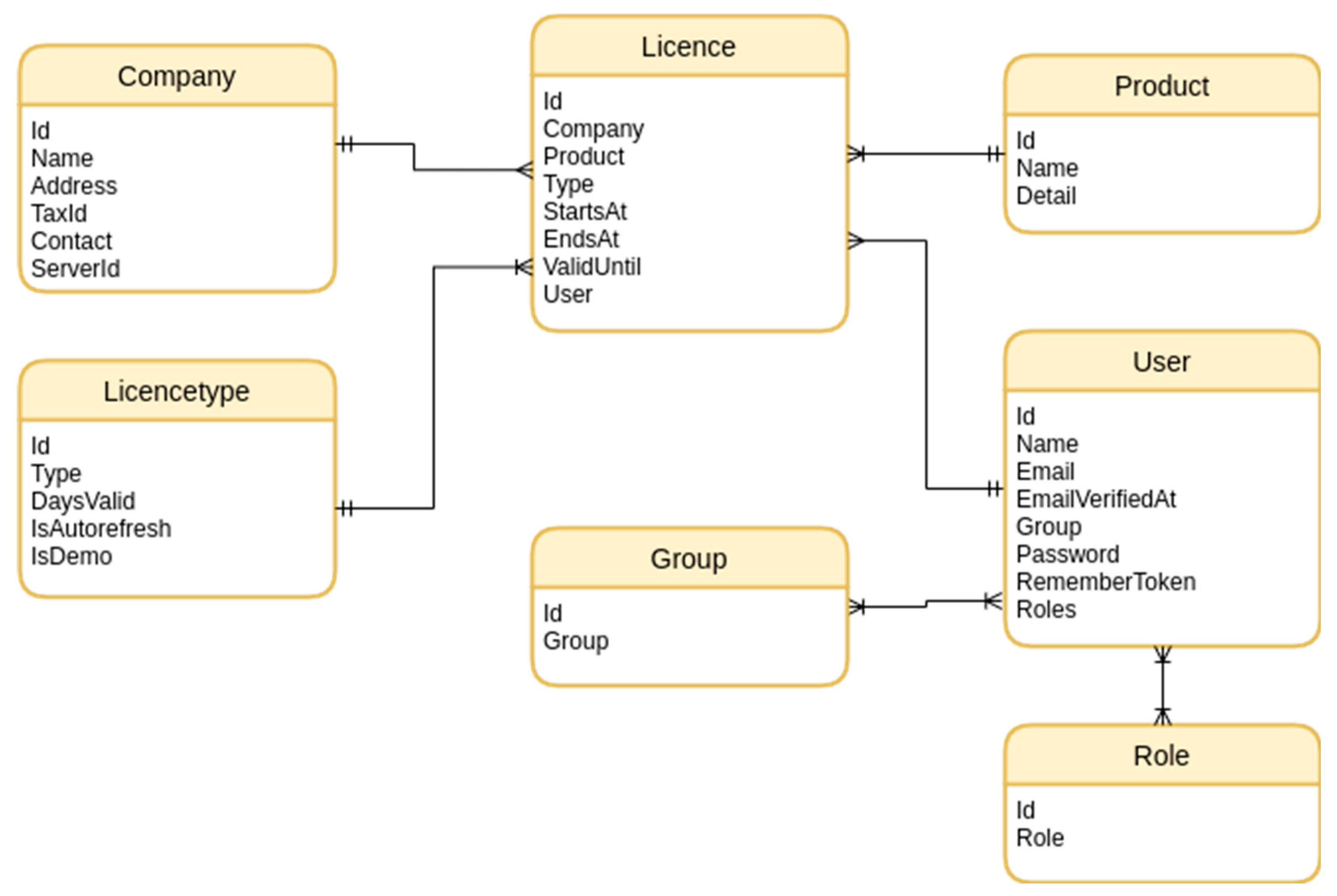


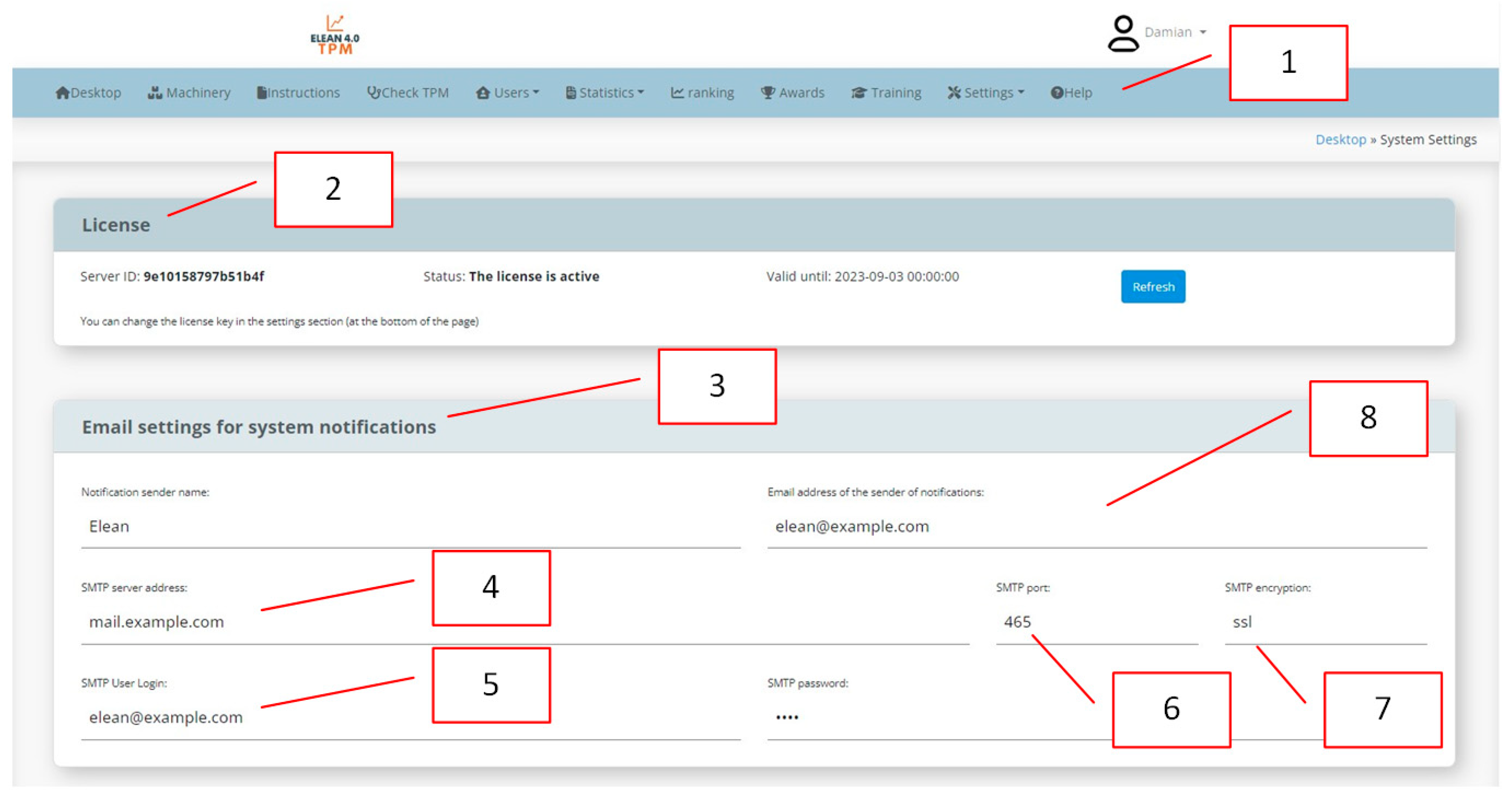
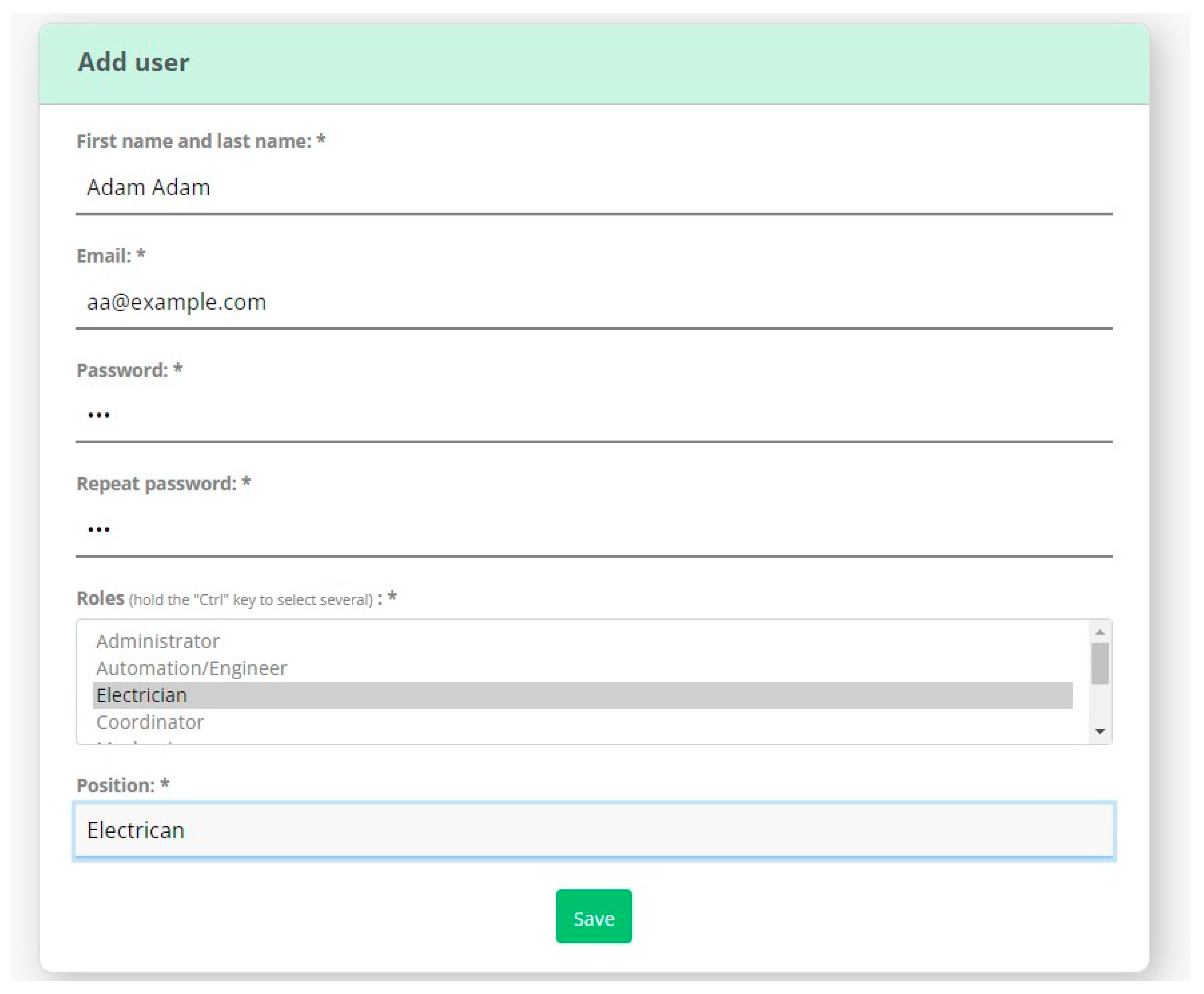
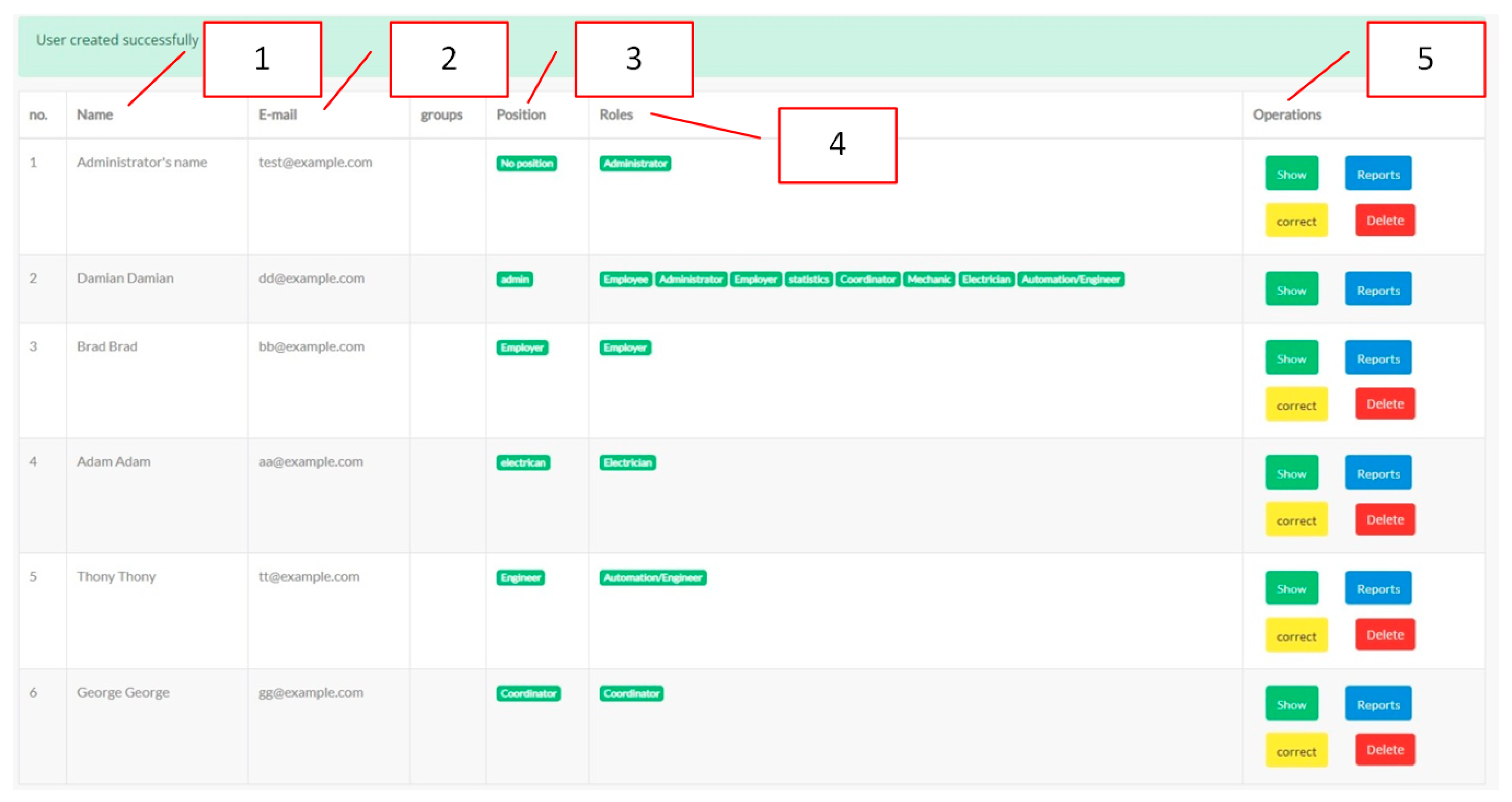


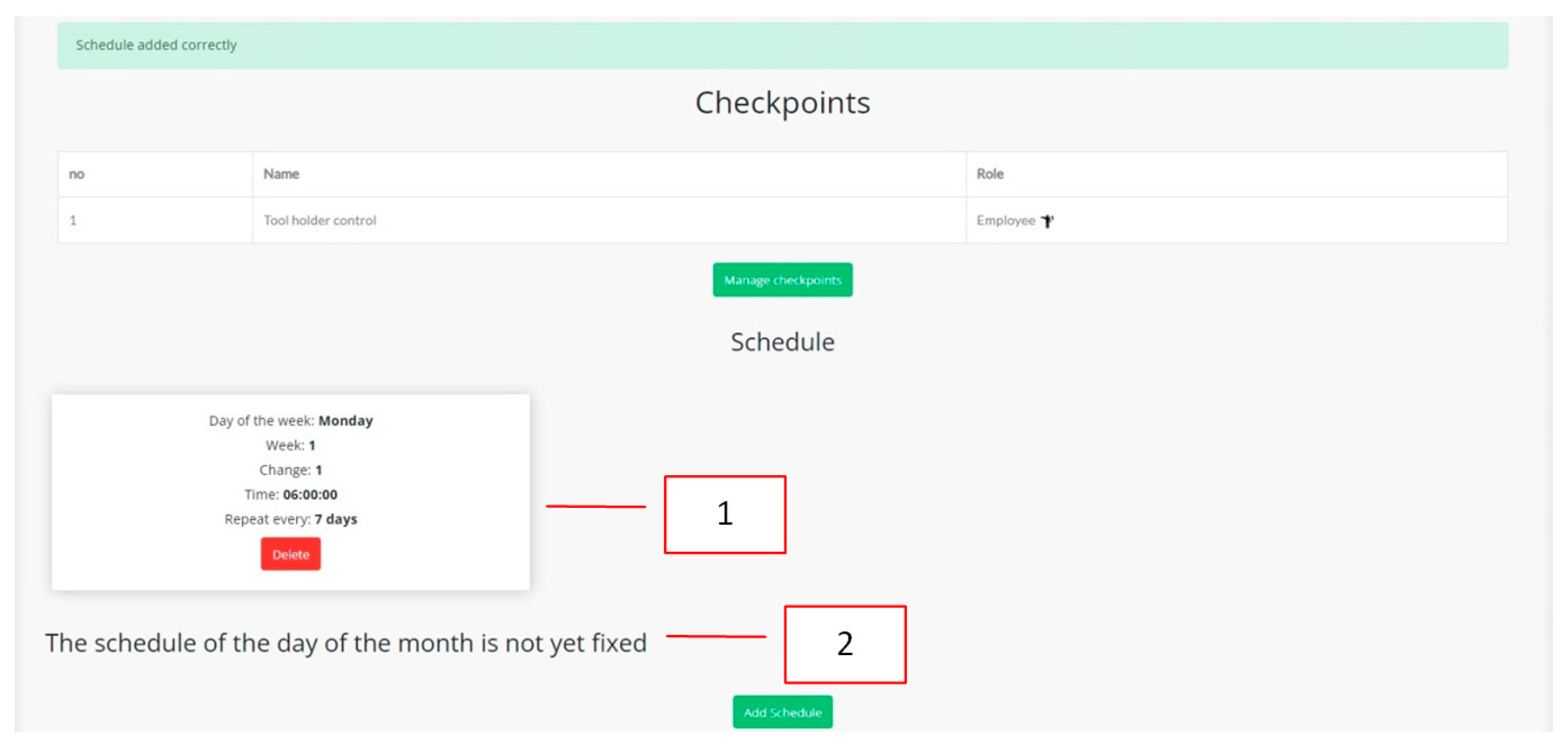
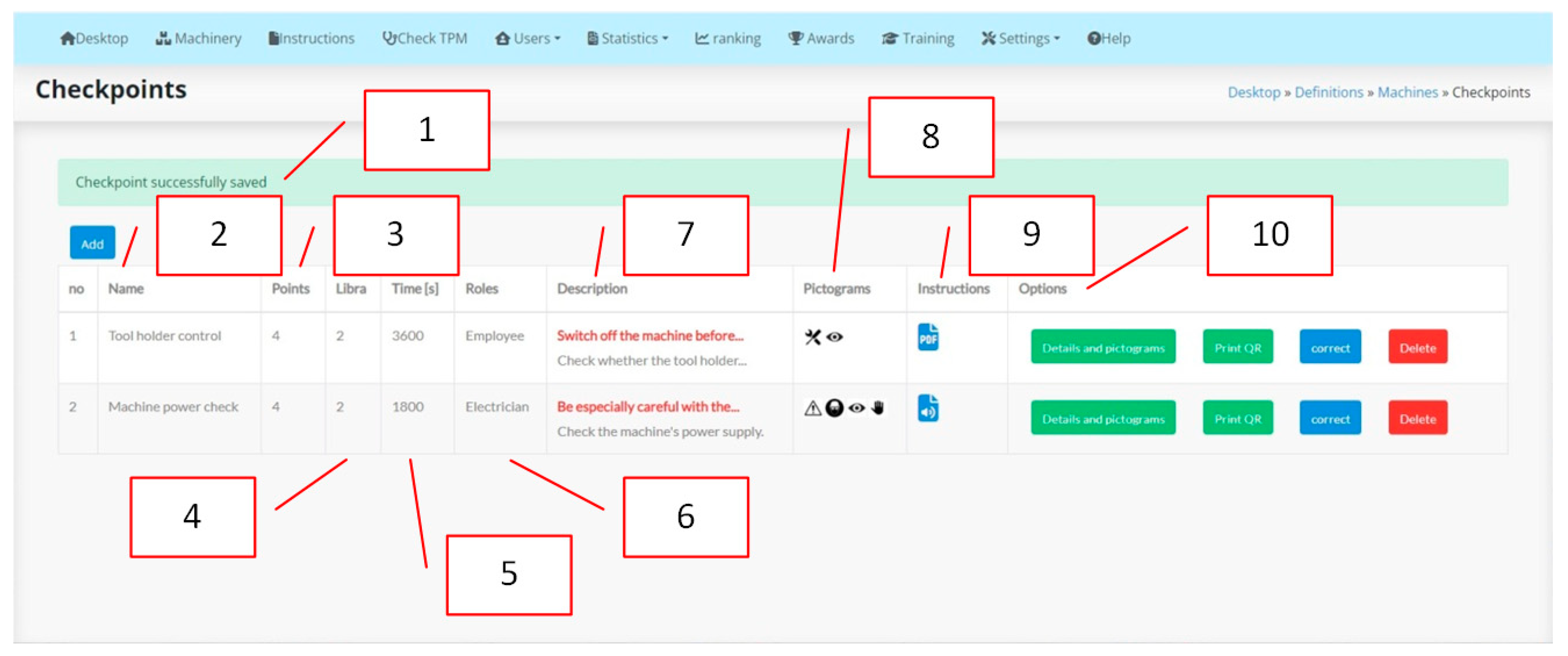




| Checkpoints | TPM Control | |||||||
|---|---|---|---|---|---|---|---|---|
| Conventional | E-Lean | |||||||
| Time [s] | Added Value | Yes | No | Time [s] | Added Value | Yes | No | |
| 1st checkpoint—polymerization furnace | 900 | System approval of the control requires all checkpoints to be passed | — | x | 873 | System approval of the control requires all checkpoints to be passed | x | — |
| Direct access by superiors to control activities and their statutes | — | x | Direct access by superiors to control activities and their statutes | x | — | |||
| Control photos of machines placed in the system, with easy access | — | x | Control photos of machines placed in the system, with easy access | x | — | |||
| Optimization of work (optimal number of steps taken by the employee during the inspection and time) | — | x | Optimization of work (optimal number of steps taken by the employee during the inspection and time) | x | — | |||
| Efficient employee motivation system (collection of points) | — | x | Efficient employee motivation system (collection of points) | x | — | |||
| 2nd checkpoint—packing area | 900 | System approval of the control requires all checkpoints to be passed | — | x | 810 | System approval of the control requires all checkpoints to be passed | x | — |
| Direct access by superiors to control activities and their statutes | — | x | Direct access by superiors to control activities and their statutes | x | — | |||
| Control photos of machines placed in the system, with easy access | — | x | Control photos of machines placed in the system, with easy access | x | — | |||
| Optimization of work (optimal number of steps taken by the employee during the inspection and time) | — | x | Optimization of work (optimal number of steps taken by the employee during the inspection and time) | x | — | |||
| Efficient employee motivation system (collection of points) | — | x | Efficient employee motivation system (collection of points) | x | — | |||
| 3rd checkpoint—defibering machines | 14,400 | System approval of the control requires all checkpoints to be passed | — | x | 12,240 | System approval of the control requires all checkpoints to be passed | x | — |
| Direct access by superiors to control activities and their statutes | — | x | Direct access by superiors to control activities and their statutes | x | — | |||
| Control photos of machines placed in the system, with easy access | — | x | Control photos of machines placed in the system, with easy access | x | — | |||
| Optimization of work (optimal number of steps taken by the employee during the inspection and time) | — | x | Optimization of work (optimal number of steps taken by the employee during the inspection and time) | x | — | |||
| Efficient employee motivation system (collection of points) | — | x | Efficient employee motivation system (collection of points) | x | — | |||
| Total | 16,200 | 13,923 | ||||||
Disclaimer/Publisher’s Note: The statements, opinions and data contained in all publications are solely those of the individual author(s) and contributor(s) and not of MDPI and/or the editor(s). MDPI and/or the editor(s) disclaim responsibility for any injury to people or property resulting from any ideas, methods, instructions or products referred to in the content. |
© 2023 by the authors. Licensee MDPI, Basel, Switzerland. This article is an open access article distributed under the terms and conditions of the Creative Commons Attribution (CC BY) license (https://creativecommons.org/licenses/by/4.0/).
Share and Cite
Medyński, D.; Bonarski, P.; Motyka, P.; Wysoczański, A.; Gnitecka, R.; Kolbusz, K.; Dąbrowska, M.; Burduk, A.; Pawelec, Z.; Machado, J. Digital Standardization of Lean Manufacturing Tools According to Industry 4.0 Concept. Appl. Sci. 2023, 13, 6259. https://doi.org/10.3390/app13106259
Medyński D, Bonarski P, Motyka P, Wysoczański A, Gnitecka R, Kolbusz K, Dąbrowska M, Burduk A, Pawelec Z, Machado J. Digital Standardization of Lean Manufacturing Tools According to Industry 4.0 Concept. Applied Sciences. 2023; 13(10):6259. https://doi.org/10.3390/app13106259
Chicago/Turabian StyleMedyński, Daniel, Piotr Bonarski, Piotr Motyka, Adam Wysoczański, Renata Gnitecka, Krzysztof Kolbusz, Magdalena Dąbrowska, Anna Burduk, Zdzisław Pawelec, and José Machado. 2023. "Digital Standardization of Lean Manufacturing Tools According to Industry 4.0 Concept" Applied Sciences 13, no. 10: 6259. https://doi.org/10.3390/app13106259






